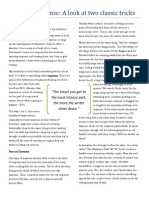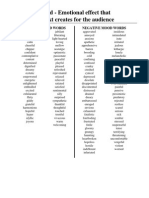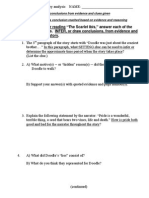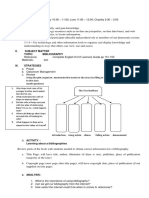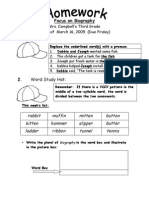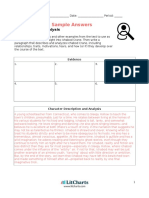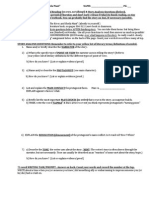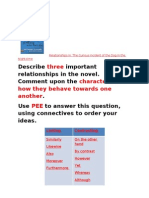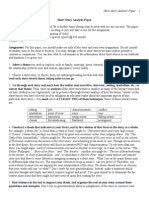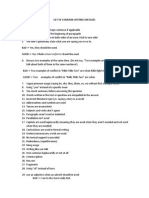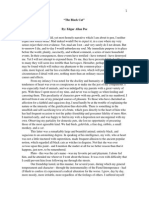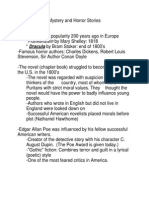Professional Documents
Culture Documents
Quotesetups
Quotesetups
Uploaded by
api-2596367730 ratings0% found this document useful (0 votes)
7K views1 pageThe document provides instructions for selecting and incorporating textual evidence from sources into writing. It explains how to introduce the evidence with an attribution, enclose the text in quotation marks, cite the source, and explain how the evidence supports the point being made. Key steps include choosing an appropriate verb for the attribution, clarifying any ambiguous pronouns, and including the page number in the citation.
Original Description:
Original Title
quotesetups
Copyright
© © All Rights Reserved
Available Formats
DOCX, PDF, TXT or read online from Scribd
Share this document
Did you find this document useful?
Is this content inappropriate?
Report this DocumentThe document provides instructions for selecting and incorporating textual evidence from sources into writing. It explains how to introduce the evidence with an attribution, enclose the text in quotation marks, cite the source, and explain how the evidence supports the point being made. Key steps include choosing an appropriate verb for the attribution, clarifying any ambiguous pronouns, and including the page number in the citation.
Copyright:
© All Rights Reserved
Available Formats
Download as DOCX, PDF, TXT or read online from Scribd
Download as docx, pdf, or txt
0 ratings0% found this document useful (0 votes)
7K views1 pageQuotesetups
Quotesetups
Uploaded by
api-259636773The document provides instructions for selecting and incorporating textual evidence from sources into writing. It explains how to introduce the evidence with an attribution, enclose the text in quotation marks, cite the source, and explain how the evidence supports the point being made. Key steps include choosing an appropriate verb for the attribution, clarifying any ambiguous pronouns, and including the page number in the citation.
Copyright:
© All Rights Reserved
Available Formats
Download as DOCX, PDF, TXT or read online from Scribd
Download as docx, pdf, or txt
You are on page 1of 1
HOW TO SET-UP AND EXPLAIN TEXTUAL EVIDENCE
1. Select appropriate textual evidence.
2. Select a lead-in to introduce the textual evidence to the reader:
a. According to ________________ (author/character/narrator), in (title of the text),
b. The narrator states,
c. ____________ (a name) states/declares/thinks/ponders/wonders/proclaims,
3. Select an appropriate verb to match the textual evidence. Is the textual evidence narration? Then the
lead-in should state that. Is the textual evidence a character thinking? Then the lead-in should state that. Is
the textual evidence a character proclaiming something with absolute certainty? You guessed itthen the
lead-in should state that.
****The verb should also match the tense in which you have chosen to write.
For example, the verbs in the above example end with s since the tense is present tense.
4. Put a comma after the lead-in.
5. Place quotation marks around the textual evidence. They should be cupping the textual evidence. See
what they look like there?
**** If the textual evidence contains an ambiguous pronoun (he, she, him, her, etc.)., clarify who that is
in brackets.
See the final example on this page .
6. Cite (give credit to author and inform reader of where information can be found) your textual evidence
by placing the authors last name and page number of the textual evidence in parenthesis.
7. The period goes after the parenthesis.
8. Explain the textual evidence. Include how the selected textual evidence supports the reason, point, or
answer.
FINAL PRODUCT:
(Keep in mind this will appear in a body paragraph somewhere after the topic sentence.)
The narrator states, He [Jonas] wept because he was afraid now that he could not save Gabriel. He no
longer cared about himself (Lowry 176). In his weakened cold, hungry, and injured condition, Jonas
weeps because he fears he will not be able to offer Gabriel a better life after successfully escaping their
community and his scheduled release. He ignores his own needs in order to bring Gabriel to an Elsewhere
in which memories, history, color, choice, and love exist. However, Jonas must remember to care for
himself since the two-year-old depends on him for survival.
You might also like
- CreatingsuspenseDocument2 pagesCreatingsuspenseapi-25963677367% (3)
- Lamb To The SlaughterDocument8 pagesLamb To The Slaughterapi-259636773Noch keine Bewertungen
- HowwriterscreatesuspenseDocument2 pagesHowwriterscreatesuspenseapi-259636773Noch keine Bewertungen
- Project Directions 17-18Document15 pagesProject Directions 17-18api-235270495100% (1)
- Four Types of Writing: Key PointsDocument5 pagesFour Types of Writing: Key Pointsnurulshafieza75% (4)
- Bubble Bath No 3Document6 pagesBubble Bath No 3api-259636773Noch keine Bewertungen
- PoetryvocabularyDocument2 pagesPoetryvocabularyapi-259636773Noch keine Bewertungen
- The LoverDocument4 pagesThe Loverapi-259636773Noch keine Bewertungen
- LittermswritingtechniquesannotationDocument4 pagesLittermswritingtechniquesannotationapi-259636773Noch keine Bewertungen
- Mood Word ListDocument1 pageMood Word Listapi-259636773100% (1)
- Tone Word ListDocument2 pagesTone Word Listapi-259636773Noch keine Bewertungen
- Study Guide: 1. Before Reading A. Extensive Reading Objectives Embedded in Animal FarmDocument6 pagesStudy Guide: 1. Before Reading A. Extensive Reading Objectives Embedded in Animal FarmMAYRA100% (1)
- ScarletibisanalysisquestionsstandardDocument2 pagesScarletibisanalysisquestionsstandardapi-233694703Noch keine Bewertungen
- Writing TipsDocument7 pagesWriting TipsSaim ShipuNoch keine Bewertungen
- ENG 2A Assignment Three QuestionsDocument2 pagesENG 2A Assignment Three QuestionsBoitumelo MolefeNoch keine Bewertungen
- Entering 12 CP BRITISH LITERATURE: Summer Reading AssignmentDocument3 pagesEntering 12 CP BRITISH LITERATURE: Summer Reading AssignmentKonstantinNoch keine Bewertungen
- Book Report AssignmentDocument2 pagesBook Report Assignmentlaurahendriksen2007Noch keine Bewertungen
- April Book Report 12Document1 pageApril Book Report 12Dana WilliamsNoch keine Bewertungen
- Learning Activity Sheet English 8Document26 pagesLearning Activity Sheet English 8Jaeda BaltazarNoch keine Bewertungen
- Creative Nonfiction Week 2 FINALDocument12 pagesCreative Nonfiction Week 2 FINALFritzie SulitanaNoch keine Bewertungen
- The Pearl Essay Prompts 2265cjpDocument2 pagesThe Pearl Essay Prompts 2265cjplordofthestringsNoch keine Bewertungen
- SEPTEMBER 4 BibliographyDocument3 pagesSEPTEMBER 4 BibliographyAida Aguilar100% (1)
- In Text Citations - PPTXPDFDocument25 pagesIn Text Citations - PPTXPDFNUR AMMIERA BINTI ZOLKEFLINoch keine Bewertungen
- CW Non Fiction SummativeDocument2 pagesCW Non Fiction SummativeRena Marie Batilaran BayhonNoch keine Bewertungen
- English 4Document90 pagesEnglish 4Marvin VillanuevaNoch keine Bewertungen
- When To SummarizeDocument4 pagesWhen To SummarizezulfirdahNoch keine Bewertungen
- Evaluating Elements of A Narrative (Character & Setting)Document15 pagesEvaluating Elements of A Narrative (Character & Setting)Nard Lastimosa100% (1)
- LiteratureCircleProjects 1Document22 pagesLiteratureCircleProjects 1eldessoukymoNoch keine Bewertungen
- Guide To Using Sources in MlaDocument3 pagesGuide To Using Sources in Mlaapi-246055540Noch keine Bewertungen
- Short Story Literary Analysis 1Document74 pagesShort Story Literary Analysis 1maria ines100% (1)
- Tpcastt Poetry For IB SocraticDocument4 pagesTpcastt Poetry For IB SocraticLee Ann SpillaneNoch keine Bewertungen
- Editor's Hat:: Focus On BiographyDocument5 pagesEditor's Hat:: Focus On BiographyAnnieNoch keine Bewertungen
- Creative NonfictionDocument5 pagesCreative NonfictionCacai Monteron Peralta100% (1)
- Character Analysis Sample AnswersDocument7 pagesCharacter Analysis Sample AnswersEllie TsakalakiNoch keine Bewertungen
- Bassriversheilamant Worksheet2Document1 pageBassriversheilamant Worksheet2api-233694703Noch keine Bewertungen
- Unit 1 SummativeDocument6 pagesUnit 1 Summativeapi-381159165Noch keine Bewertungen
- "The Stories of America" Learning Community: Acdv B50 Reading For Academic SuccessDocument61 pages"The Stories of America" Learning Community: Acdv B50 Reading For Academic Successapi-16293839Noch keine Bewertungen
- 11th Grade Summer Reading Assignment 2017Document2 pages11th Grade Summer Reading Assignment 2017Blich high SchoolNoch keine Bewertungen
- Sentence Outline WorksheetDocument4 pagesSentence Outline WorksheetRuben Rosendal De AsisNoch keine Bewertungen
- Relationships in The Novel - Obs LessonDocument5 pagesRelationships in The Novel - Obs Lessonenglishteach1983Noch keine Bewertungen
- How To Analyze A Short StoryDocument3 pagesHow To Analyze A Short StoryLilian Khalil100% (2)
- 2413 Short Story Analysis PaperDocument2 pages2413 Short Story Analysis Paper凝嫣Noch keine Bewertungen
- Reaing Journal Directions 2015Document2 pagesReaing Journal Directions 2015Lee Ann SpillaneNoch keine Bewertungen
- English 4C - Independent Study Outline: These Dates Are Subject To ChangeDocument6 pagesEnglish 4C - Independent Study Outline: These Dates Are Subject To Changeapi-476730596Noch keine Bewertungen
- Ind Novel Proj 09Document4 pagesInd Novel Proj 09Rod FobertNoch keine Bewertungen
- Summary AbstractDocument12 pagesSummary AbstractfarhanjahariNoch keine Bewertungen
- 7th Grade Reading ResponsesDocument2 pages7th Grade Reading Responsesapi-236340289Noch keine Bewertungen
- DIDACTIC SEQUENCE2 Horror Story 5thDocument21 pagesDIDACTIC SEQUENCE2 Horror Story 5thScribdTranslationsNoch keine Bewertungen
- Creative Non Fiction Module Week 2Document5 pagesCreative Non Fiction Module Week 2Arcie LorenzoNoch keine Bewertungen
- Students Academic Writing Citation GuideDocument7 pagesStudents Academic Writing Citation GuideCoach EchaNoch keine Bewertungen
- A Guide To Writing The Literary Analysis EssayDocument9 pagesA Guide To Writing The Literary Analysis Essayapi-249002674Noch keine Bewertungen
- Descriptive CompositionDocument2 pagesDescriptive CompositionRon Paul StarNoch keine Bewertungen
- Creative Nonfiction Q3 Module 2 - Lesson 2Document8 pagesCreative Nonfiction Q3 Module 2 - Lesson 2Janine MagnayeNoch keine Bewertungen
- Catcher in The Rye Essay Outline WorksheetDocument3 pagesCatcher in The Rye Essay Outline WorksheetjzartlerppsNoch keine Bewertungen
- Poetry Explication Worksheet: Exercise 1Document5 pagesPoetry Explication Worksheet: Exercise 1BB SlNoch keine Bewertungen
- 10th Grade Summer Reading Assignment 2017Document1 page10th Grade Summer Reading Assignment 2017Blich high SchoolNoch keine Bewertungen
- A Man Falls To His DeathDocument11 pagesA Man Falls To His DeathTheodore BaltazarNoch keine Bewertungen
- A Man Falls To His Death PDFDocument11 pagesA Man Falls To His Death PDFLamia MendezNoch keine Bewertungen
- Dr. Cirilo F. Bautista's Online Publications: A Man Falls To His DeathDocument11 pagesDr. Cirilo F. Bautista's Online Publications: A Man Falls To His DeathAl Jireh MalazoNoch keine Bewertungen
- 3rd Quarter PPTsDocument173 pages3rd Quarter PPTs-------100% (2)
- Literary EssayDocument30 pagesLiterary EssayTameeYoonNoch keine Bewertungen
- Book Report Paris LibraryDocument2 pagesBook Report Paris LibraryBloeme LeijsNoch keine Bewertungen
- Times New Roman, 12, Line Space 1,5, Margin Space: 2,5Document7 pagesTimes New Roman, 12, Line Space 1,5, Margin Space: 2,5agtshahidNoch keine Bewertungen
- Study Work Guide: Cry, the Beloved Country Grade 12 First Additional LanguageFrom EverandStudy Work Guide: Cry, the Beloved Country Grade 12 First Additional LanguageNoch keine Bewertungen
- Antidisestablishmentarianistically Speaking: More Captions to the Cartoons We LiveFrom EverandAntidisestablishmentarianistically Speaking: More Captions to the Cartoons We LiveNoch keine Bewertungen
- CubesmathmethodposterDocument1 pageCubesmathmethodposterapi-259636773Noch keine Bewertungen
- 11 Ways To Title A StoryDocument1 page11 Ways To Title A Storyapi-259636773Noch keine Bewertungen
- All Summer in A DaystoryDocument4 pagesAll Summer in A Daystoryapi-259636773100% (1)
- Whaley House Girlatthewindow InfotextDocument4 pagesWhaley House Girlatthewindow Infotextapi-259636773Noch keine Bewertungen
- List of Common Writing MistakesDocument2 pagesList of Common Writing Mistakesapi-259636773Noch keine Bewertungen
- MlaformatDocument2 pagesMlaformatapi-259636773Noch keine Bewertungen
- No Excuse2015Document1 pageNo Excuse2015api-259636773Noch keine Bewertungen
- InfinitivesDocument5 pagesInfinitivesapi-259636773Noch keine Bewertungen
- SaidDocument2 pagesSaidapi-259636773Noch keine Bewertungen
- MoremlarulesDocument2 pagesMoremlarulesapi-259636773Noch keine Bewertungen
- The Black CatDocument7 pagesThe Black Catapi-259636773Noch keine Bewertungen
- Porphyrias LoverDocument1 pagePorphyrias Loverapi-259636773Noch keine Bewertungen
- Mystery and Horror StoriesDocument1 pageMystery and Horror Storiesapi-259636773Noch keine Bewertungen


